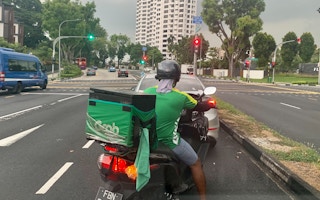The head of sustainability for ride-hailing giant Grab has said that electric vehicles (EVs) are “nowhere close” to the affordability and performance of petrol-powered vehicles in Southeast Asia, as the company looks to lower its climate impact by electrifying its fleet.
To continue reading, subscribe to Eco‑Business.
There's something for everyone. We offer a range of subscription plans.
- Access our stories and receive our Insights Weekly newsletter with the free EB Member plan.
- Unlock unlimited access to our content and archive with EB Circle.
- Publish your content with EB Premium.
Cheryl Goh, the Singapore-based firm’s vice president of marketing and sustainability, said that the total cost of ownership of a four-wheel EV is 82 per cent higher than an equivalent internal combustion engine (ICE) car in Southeast Asia, putting electric mobility out of reach for the mainly lower income ride-hail and delivery drivers that use Grab’s app.
Grab’s five million drivers across the region account for 96 per cent of the firm’s total emissions. The high cost of EVs is one reason why Grab recently announced a climate target that aims for carbon neutrality by 2040, rather than a bolder science-based target that aligns the firm with the Paris Agreement on climate change.
Grab’s Indonesian rival ride-hailing firm Gojek said it would be a zero-emissions company by 2030, a target it announced in May last year.
In Indonesia, Grab’s largest market, a regular ICE motorbike costs around US$1,000, while the lowest-priced EV costs around US$1,300, Goh said at the Ecosperity conference in Singapore on Wednesday. “The prices may seem comparable. But in reality, the power and the performance [of the electric motorbike] is nowhere close.”
An EV of comparable power and performance is almost double the price of an ICE vehicle, Goh said. “We still have a long way to go [for EVs to reach mass adoption in Southeast Asia].”
“
For Grab drivers, a vehicle isn’t a luxury item or a status symbol. It is a way to earn an income. Our drivers are very sensitive to vehicle cost, because it directly impacts how much money they can bring home to their families.
Cheryl Goh, group vice president, marketing and sustainability, Grab Holdings
Replacing batteries is also expensive and there is uncertainty over the resale value of EVs, she added.
Grab is trying to increase EV adoption among its drivers with a variety of initiatives to lower their cost, including a financing programme in Thailand, a rental scheme in Indonesia, and a reduced-rate charging system in Singapore.
“For electric mobility to really scale [in Southeast Asia], and to help our drivers transition [to clean energy-based vehicles], it needs to be inclusive, and it needs to be affordable for the masses,” she said.
Another way to reduce the cost of EVs is for drivers to rent batteries, a service that EV manufacturer Nio launched in China in 2020, which has enabled a 20 per cent reduction in the overall cost of the vehicles, according to Nikolaus Lang, managing partner, Boston Consulting Group.
Battery-swapping offers an opportunity to make running electric two-wheelers more convenient for riders in Southeast Asia. Gojek started piloting battery-swapping in Indonesia through a partnership with Taiwanese e-mobility firm Gogoro last year in Indonesia.
However, the battery-swapping model faces challenges if riders own the bikes, Goh observed. “They [e-bike owners] are quite afraid that they will swap for a less productive battery.”
Goh noted that the most affordable e-bikes lack battery-swapping capabilities. “We have three to four different models of e-bikes, but the challenge is that everybody uses different batteries.”
“Battery interoperability is going to be super important so that e-bikes can scale,” she said.
Range anxiety — worrying that the battery will run out — is a genuine fear among Grab drivers, and another reason why the transition to electric vehicles has been slow, Goh said.
“Our drivers drive for an average of 430 kilometers a day in Singapore alone — that is seven times more than the average driver. This means they need to spend a lot of time charging their batteries at a charging station. That is time they could be spending on the road, which is an opportunity cost,” she said.
“Range anxiety is something that truly makes drivers think what the transition to EVs really means,” she said.
EVs’ share of global vehicle sales grew from 4 per cent in 2020 to 8.6 per cent in 2021, but EVs still only make up 1-3 per cent of sales in Southeast Asia, according to data from Boston Consulting Group.












